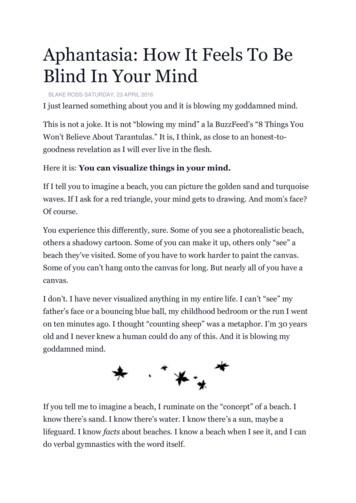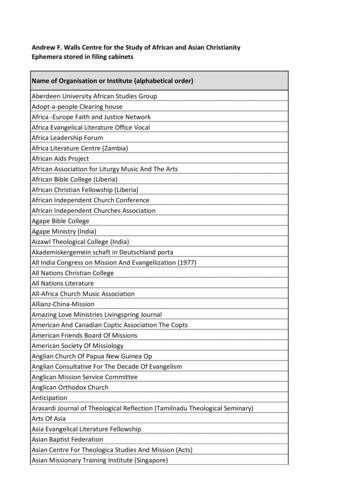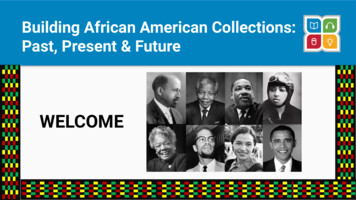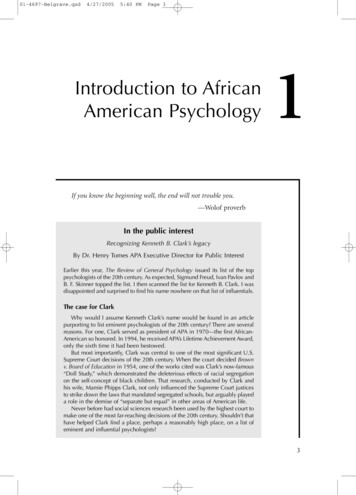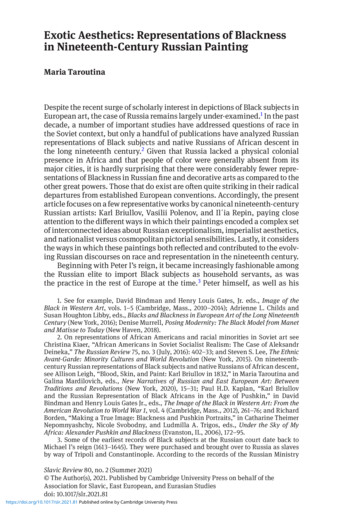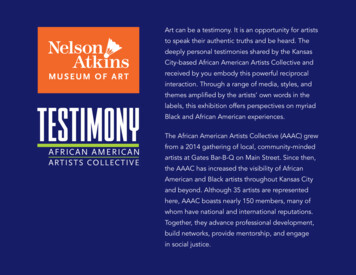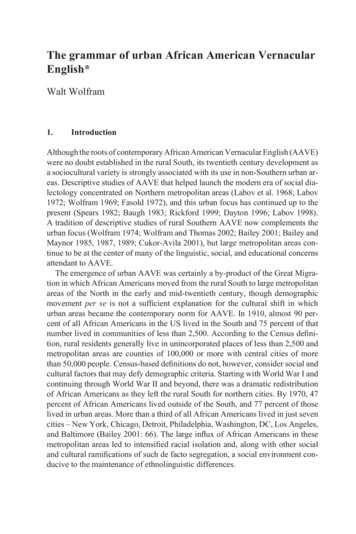
Transcription
BLACKNESS WRITES BACK: CONTEMPORARY AFRICAN-AMERICAN REVISIONS OF GOTHIC RACIAL IDEOLOGIESByMAISHA LAKAYE WESTERA DISSERTATION PRESENTED TO THE GRADUATE SCHOOLOF THE UNIVERSITY OF FLORIDA IN PARTIAL FULFILLMENTOF THE REQUIREMENTS FOR THE DEGREE OFDOCTOR OF PHILOSOPHYUNIVERSITY OF FLORIDA2006
Copyright 2006byMaisha Lakaye Wester
To my friends and family, wherever you are
ACKNOWLEDGMENTSI would like to thank my family for supporting me throughout my many years ofeducation. I would also like to thank my friends for keeping me grounded during thesometimes tedious and difficult process of writing a dissertation.I also must extend my profound gratitude to the members of my dissertationcommittee for their guidance and patience. I particularly want to thank them for theirwillingness to endure countless long-winded and grammatically monstrous revisions.Last, but certainly not least, I want to thank my dissertation advisor and chair, MaliniSchueller, for her wisdom and support, and for insisting that I engage intellectuallystrenuous theorists and concepts.iv
TABLE OF CONTENTSpageABSTRACT. viiCHAPTER1INTRODUCTION: THE GOTHIC OLD AND NEW, BLACK AND WHITE .1A Brief History of Otherness and the Gothic in America .4The African-American Gothic.20The Aims and Intent of Blackness Writes Back.34Notes .382HAUNTED LANDS AND GOTHIC VOICES: SLAVE NARRATIVE REWRITINGS OF GOTHIC MOTIFS .43Theorizing the Slave’s Narrative: A Brief Introduction .45The Slaves' Narrative: Gothic Challenges and Changes.51The Bondswoman’s Narrative: Fictionalizing the Slave’s Narrative .78Challenges of Form.90Notes .953MONSTROUS WIVES AND HORRIBLE HUSBANDS: NAYLOR'S USE ANDCRITIQUE OF GOTHIC CONVENTIONS IN LINDEN HILLS .98Gothic Anxieties and Suppression of the Margin(alized).103The Lost History of Women’s Experiences.124Distorted Realities and Masked, Monstrous Beings.133Re-envisioning (Maternal) History.145Notes .1584THE LOST VOICES OF TIMS CREEK: NARRATIVE RE-INSCRIPTION IN AVISITATION OF SPIRITS AND "LET THE DEAD BURY THEIR DEAD" .161Normative (?) Communities .165The Demonic Other’s Exorcisms.179Haunting Sacrifices.195The Haunting of Oral Narratives .200v
Notes .2235“MURDERED BY PIECE-MEAL:” SLAVERY’S LEGACY AND THEDESTRUCTION OF AFRICAN-AMERICAN FAMILY IN BELOVED .227Beloved Who Was Not Beloved, Home That Was Not Home.235Monstrous Mothers.243Fleeing Fathers.254Slaughtered Siblings .268“Good Is Knowing when To Stop”.276Notes .2856CONCLUSION: THE REVISED GOTHIC AS VEHICLE FOR CULTURALMEMORY AND RESISTANCE .289Notes.300LIST OF REFERENCES.302BIOGRAPHICAL SKETCH .311vi
Abstract of Dissertation Presented to the Graduate Schoolof the University of Florida in Partial Fulfillment of theRequirements for the Degree of Doctor of PhilosophyBLACKNESS WRITES BACK: CONTEMPORARY AFRICAN-AMERICANREVISIONS OF GOTHIC RACIAL IDEOLOGIESByMaisha Lakaye WesterDecember 2006Chair: Malini SchuellerMajor Department: EnglishThe following analysis discusses how and why contemporary African-Americanwriters re-appropriate Gothic tropes to engage the racial discourses encoded within whiteAmerican Gothic texts. These writers also read discourses of sexual and genderoppression through and against race in their text to suggest that these multipleoppressions overlap and contribute to each other. Furthermore, in re-appropriating thegenre’s tropes, Contemporary African-American authors critique the genre and negate theoppressive ideologies inscribed within the form by re-inscribing the genre with Blackcultural experiences. Indeed, the genre’s tropes, once re-written, prove useful forarticulating the peculiar complexities and terrors of being African-American.I posit two specific ways contemporary black authors critique and re-appropriatethe Gothic genre. The first method is by merely inverting the tropes racial allusions. Insuch inversion black/ night/ wilderness, for instance, becomes connotative of goodnesswhile white/ daylight/ “civilization” connotes evil. The second method is throughvii
revising the tropes to take the horror out of the Gothic supernatural and resituate it inAfrican American’s lived experiences. Authors accomplish this by creating charactersthat have mild and/ or humorous responses to Gothic supernatural events. By making thetypical supernatural terrors of the genre relatively inane, black authors emphasize thehorror of African-American reality.Although this project primarily focuses upon Gloria Naylor, Randall Kenan, andToni Morrison, the conclusions it draws from their work are applicable to numerous otherblack writers, such as Alice Walker, who resort to Gothic tropes even within non-gothictexts. I illustrate how black writers repeatedly destabilize concepts of history andidentity. Consequently the project also challenges traditional notions of identity andhistory and reveals them as incomplete and constructed narratives. Lastly, this projectevaluates how politics and discourses of otherness silences and erases the histories ofmarginalized groups. The histories of these groups are inevitably sacrificed in order tomaintain the dominant culture’s narrative. Through my analysis of the various blacktexts, I posit such dominating and oppressing history as problematic; I furthermoresuggest that the dominant culture actually suffers from its suppression of Others’histories.viii
CHAPTER 1INTRODUCTION: THE GOTHIC: OLD AND NEW, WHITE AND BLACKThe recent trend in research on American Gothic literature has been to look at theracial ideologies espoused therein. Criticism on the genre’s conventions as inscriptionsof the hermeneutics of race abounds, and the shape-shifting face of the racial Otherrepeatedly surfaces in the fiction and interpretation. Whereas earlier critics such as LeslieFiedler and Harry Levin focused upon white male paranoia over and reaction totransgressed boundaries, recent critics have begun to emphasize how this paranoiareaffirms the racial and sexual boundaries as social constructs used to sustain whitepatriarchal dominance. Both generations of critics mark how the genre’s plots oftenillustrate a transgression of boundaries even as the text seeks to reinforce the verycategories it marks as frighteningly unstable. Critics argue that gothic tropes of hauntedlandscapes and people, mistaken identities and family secrets, pursued/ tormentedheroines and “dark,” raping villains in a diseased and decaying world refer to fears ofracial transgression and contamination. In the American Gothic, the trope of theunspeakable is a silent meditation upon both sexual and racial transgressions asmiscegenated monsters threaten to destabilize constructions of race and sexuality.Critics have also viewed both the European and Anglo-American gothic as anillustration of how the past comes to bear upon the present. Historical wrongs surface in(familial) curses and hauntings. Even in American literature, where supernaturaloccurrences are often explained away as misperception by the gothic tale’s conclusion, 1upbringing is often brought to bear upon the character responsible for the flights of fancy.1
2History remains present in such explanations, even when it is individualized into afamilial narrative to explain a particular character’s mental processes. Robert Martin,furthermore, notes the extent to which even these “individualized” narratives repeatsocial narratives and histories. Referring to The House of the Seven Gables as hisprincipal text in an examination of familial roles in Hawthorne’s tales, Martin concludesthat the text conceals “a racial history of slavery which at least in part shifts the novel’stheme away from family guilt to national guilt or uses the family as a synecdoche of thenation” (Martin, Robert 130). As issues of slavery and abolition grew increasinglyweighty in the American mind, the gothic became the tool of racialized discourse, thegenre’s vocabulary disguising discussions of what Toni Morrison has called the“Africanist presence.” Recorded within the genre’s motifs and plots were racialdefinitions and fears, questions and re-visions of racial difference, and re-writings ofhistorical events such as slave uprisings and white slaughter of Native Americans.Yet very little has been said on the way in which the racial Other appropriates thegenre to write to/ against the ideologies of the gothic. Justin Edwards is one of a fewtheorists who notes how the gothic’s innate instability as a genre was adopted by earlyand late African-American writers to de-scribe the racial ideologies that the gothic oftenserved. His text, Gothic Passages: Racial Ambiguity and the American Gothic, explainshow the question of passing became a gothic trope formulated first by nineteenth-centurywhite American writers to speak to the terrors of miscegenation. The trope wasreformulated by black writers to assert racial mixing as a destabilizing force, allowingthem to redefine race as a fluid, socially imagined category rather than a scientificallyfixed fact.
3Edwards’ text does not deal with writers after Reconstruction, even as he notes inhis conclusion that further re-appropriation of the gothic occurred in twentieth centuryblack texts. It is here, with contemporary African-American literature, that I propose toanalyze strategies of gothic re-vision. Blackness Writes Back examines the manner inwhich contemporary Black texts go beyond merely inverting the color scheme of thegothic trope—blackened evil that torments and is defeated by good whiteness—todestabilizing the entire notion of categories and boundaries.I illustrate how contemporary Black literature returns to the idealized revolutionarypower of the Gothic as a de-centering principle, first formulated in John Ruskin’s “TheNature of the Gothic” and elaborated upon in Geoffrey Harpham’s On the Grotesque. 2 Inrevising the genre contemporary African-American writers also critique and complicatethe identities white Gothic writers imposed upon them. The texts engage thepoststructuralist concepts of writing and identity espoused by Trinh T. Minh-ha: “Writingnecessarily refers to writing. [. . . .] A writing for the people, by the people, and from thepeople is, literally, a multipolar reflecting reflection [. . . .] I write to show myselfshowing people who show me my own showing” (Minh-ha 22). Black gothic, as a“multipolar reflecting reflection” 3, reveals the archetypal depictions of racial, sexual, andgendered others as constructions useful in the production of white patriarchal dominance.These authors also destabilize and defy any singular projections of their own identity as itinevitably shifts and changes among the various interacting social categories andhierarchies.I must note that I use a “Queer of Color” critique as the basis of my elaborationupon the intersections of race, sexuality, and gender in these texts. A “Queer of Color”
4critique, according to Roderick Ferguson’s description in Aberrations in Black, definesracist practice’s articulation of itself as gender and sexual regulation (Ferguson 3).Through examining the numerous instances in which nation has been and is a “domaindetermined by racial difference and gender and sexual conformity,” Ferguson concludesthat gender and sexual transgressions frequently signify racial difference, and vice versa,in dominant narrative. Similarly, Siobhan Somerville’s text Queering the Color Linehistoricizes the increased policing of racial boundaries that occurred alongside emergingcategories of sexual identity to conclude that “homosexuality as the condition, andtherefore the identity, of particular bodies was . . . a historical production” extensivelyintertwined with the production of race (Somerville 3). Thus this project assumes thatmany of the racist ideologies responsible for the oppression of black bodies lendthemselves to sexism and homophobia; more importantly, instances of sexism andhomophobia recall and re-inflict assaults upon the black body, regardless of thecommunity that perpetrates it, because dominant (white patriarchal) narrative constructsthese other transgressions against and through race. 4A Brief History of Otherness and the Gothic in AmericaHistoricizing the gothic shows us that it most often registers and draws on racialfears and strifes for some of its darkest images. Indeed, Toni Morrison notes that thediscourse of slavery and freedom, and consequently a racial discourse as well, was soabundant during the nineteenth century that “[i]t would have been an isolato indeed whowas unaware of the most explosive issue in the nation . . . . What did happen frequentlywas an effort to talk about these matters with a vocabulary designed to disguise thesubject” (Playing 50) 5. In Europe the gothic gave voice to somewhat fanatical andrepetitious evocations of racial difference and conflict, terror and disgust. It was a genre
5giving voice to racist ideologies and fears (Malchow 3). 6 Indeed, between 1790 and1830, the growing concerns and debates over slavery occurred contemporaneously withthe rise of the gothic novel (Goddu 73). It was during this period that such paintings as ANegro Overpowering a Buffalo and The Negro Revenged, as well as poems like “TheDying Negro” became abundant, illustrating underlying fears of the racial “Other” aspowerful, vengeful and destructive 7. Notably, both the need to delineate race anddisguise its discourse influenced the Gothic genre’s anxiety over and portrayal ofqueerness. As Somerville explains, towards the end of the nineteenth centurythe formation of notions of heterosexuality and homosexuality emerged in the U.S.through (and not merely parallel to) a discourse saturated with assumptions aboutthe racialization of bodies. These assumptions and the heightened survaeillance ofbodies in a racially segregated culture demanded a specific kind of logic, which . . .gave coherence to the new concepts of homo-and heterosexuality. (4)Thus in both the culture and its fiction, the racist logic that first racialized distinctionsbetween “slave” and “free,” and later refigured them in exclusively racial terms of“black” and “white,” also provided the impulse and logic between sexual distinctions.Americans during the late eighteenth and nineteenth century turned to the Gothic asa discourse through which to contemplate issues of colonization, subjugation, and theplace of the racial other. The genre’s plots and tropes reflected the increasingly frequentdebates on slavery that were accompanied by questions on the place of the Black inAmerica. Indeed, though many in the northern United States agreed that slavery shouldbe abolished, few clearly agreed upon what to do with Blacks if they were freed.Questions arose over whether such a group could join “civilized” society or if such amingling of the races lead to the degradation and eventual destruction of white society.Old rumors of the brutality and savageness of the slaves, and Native Americans, 8 inaddition to the recent bloody uprisings such as that led by Nat Turner in 1831, did not
6bode well and only fueled white fear of racial intermingling. Such fear was onlyaugmented by notions that white and black relations would inevitably degrade, if notdestroy, whites, as proven by Nat Turner’s “savage” attack. Thus Leslie Fiedlerconcludes that “[i]t is, indeed, to be expected that our first eminent Southern authordiscovered that the proper subject for the American gothic is the black man, from whoseshadow we have not yet emerged” (Fiedler 397).A great part of the racial concern came from paranoia over maintaining distinctsocial boundaries. As Malchow notes, “the hunger for systematic and verifiableknowledge that typifies the mid-century philosophe . . . [led to] an inevitable compulsionto rank not only cultures but also types of people” (Malchow 10). Such compulsion ledto an obsessive need to ensure the maintenance of boundaries once they were established.Morrison cites, among her list of “understandably human fears,” Americans’ fear ofboundarylessness (36). Such obsessions supported the preponderance of segregationistlaws, which survived for nearly a century after abolition. There was a surplus of lawsforbidding intermarriage between “any white person with any negro, Indian, or mulatto”under penalty of a fine, for both the couple and the presiding minister, or even servitude.Transgression of boundaries proved particularly disruptive. Racial transgressionembodied in “half-breeds,” in the form of various miscegenated monsters such asvampires, proved particularly threatening and terrifying. Indeed, both the “half-breed”and the vampire, for instance, are insidious because of their ability to mask their presenceamong an unsuspecting white population and pollute and infect the surrounding people(Malchow 168). The image of the vampire as “half-breed” illustrates the fear of whatmuch of white society feared would happen once racial boundaries were transgressed—
7whiteness would be irrevocably contaminated and inevitably consumed and destroyed. Inthe white world outside of fiction, infection and consumption were viewed in a number ofways. Fear of contamination was often perceived in terms of psychological and moraldeficiencies, in addition to blood contamination as illustrated through the creation of“half-breeds.” For example, in Review of the Debate in the Virginia Legislature of 1831& 1832 Thomas Dew states that in response to increasing black presence, whites wouldeither have to withdraw from Virginia or suffer degeneration: “the blacks, by closerintercourse, would bring the whites down to their level. In the contact between thecivilized and uncivilized man, all history and experience show, that the former will besure to sink to the level of the latter. In these cases it is always easier to descend thanascend, and nothing will prevent the facilisa descensus but slavery” (Dew 101).Likewise, research in the 1880s often attributed degeneracy in whites to racialcontamination, noting that often degenerates had a relative who was of mixed blood(Newitz 2). Yet the proximity of blacks did not end with the idea of the black ascontaminant but continued with the idea of the black as violent monster.Images of violence were often coined in gothic terms. Thomas Dew’s descriptionof the “violent negro” strikingly resembles the description of the Frankenstein monster.Elaborating upon the growing threat the slave poses to his master/ creator, Dew describesthe slave as “a human form with all the physical capabilities of man, and with the thewsand sinews of a giant;” like Frankenstein to his monster, the slave master fails to “impartto [his slave] a perception of right and wrong [and] finds too late that he has only createda more that mortal power of doing mischief, and himself recoils from the monster whichhe has made” (Dew 105). Black “monsters” were feared as inevitably destructive to
8white patriarchal society, consuming an invaluable commodity—white women. Indeed,the horror of the “black rapist” was a story frequently told in periodicals and magazines,reducing free-roaming blacks to the level of barbarous beasts and feral fiends from whichno woman was safe. In an anonymous editorial from the 1860 pamphlet Cotton is King,one reader complains of the frequent attacks by free blacks on white women, using suchterms to describe the blacks as “wild beasts of the forest” and “inhuman”, and concludinghis narrative by noting that the stories are so horrific that he cannot hear them withoutshuddering (“Social” 240).Mid-nineteenth century newspapers frequently gave accounts of black violence andslave rebellion using gothic terms and tropes. Indeed, in 1831 Nat Turner becameinfamous for his rebellion, and his story was often told in tones of a gothic narrative.Thomas Dew’s account of the event exemplifies the appropriation of the tropes:It is well known that during the last summer, in the county of Southampton inVirginia, a few slaves, led on by Nat Turner, rose in the night, and murdered in themost inhuman and shocking manner, between sixty and seventy of the unsuspectingwhites of that county. The news, of course, was rapidly diffused, and with itconsternation and dismay were spread throughout the State, destroying for a timeall feeling of security and confidence; and even when subsequent development hadproved, that the conspiracy had been originated by a fanatical negro preacher . . .still the excitement remained, still repose of the commonwealth was disturbed,—for the ghastly horrors of the Southampton tragedy could not immediately bebanished from the mind—and Rumor, too, with her thousand tongues, was busilyengaged in spreading tales of disaffection, plots, insurrections, and even massacres. . . . (Dew 6)Even within this description there are aspects of contamination anxieties in the form ofboth rumors which contaminate white peace of mind, as well as, within the samesentence, the possible spread of rebellious and murderous ideologies to other slaves.Likewise his description of Turner as “inhuman” and “fanatical,” the originator of“ghastly horrors” against innocent and “unsuspecting” whites, has undertones of the
9gothic monster that attacks without cause or warning. Newspapers of the periodpublished similar descriptions of the event, turning the rebels into savage beasts anddescribing the rebellion with prose that had a particularly fictional and gothic quality.Lesley Ginsberg concedes that periodicals, such as the Enquirer, “participate[d] in theproduction of a cultural convention: the creation of a national gothic narrative whoseconspicuously fictive framework masks the real horror of race war” (100). Thus factualand political accounts often trail into a narrative robust with gothic imagery.American Gothic texts inevitably represented and echoed national fears of racialmiscegenation, contamination, and destruction. White male writers figuratively andliterally represented the enslaved black body in their texts as a manner of meditating uponblack monstrosity, civility, and threat. In The Narrative of Arthur Gordon Pym forinstance, Poe depicts stereotypical images of slaves and slave rebellion. The Too-Witsoccupy the Island of the Tsalal, which is located in the Southern most region of theworld. Likewise, the geography of the island marks it as a symbolic representation of theAmerican South; Pym identifies the island by a ledge that “bear[s] a strong resemblanceto corded bales of cotton” (Poe 160). The natives of this Southern land are extremelyblack 9 and seemingly ignorant, simplistic, and savage. Yet the novel reveals the TooWits’ ignorance as a mere mask because they stage an attack upon Pym’s unsuspectingwhite companions. Lastly, the relationship between the islanders and the white crew ofthe Jane Guy suggests that this attack represents more than the hidden threat the loosedblack body poses; the Too-Wits’ betrayal is actually a kind of slave uprising. In bothBenito Cereno and “The Bell-Tower” Melville similarly imagines the enslaved body asduplicitous and deadly. Yet according to Harry Levin, Melville revises the relationship
10between slave and master to posit the black as a Frankenstein monster that destroys itsenslaver/ creator. Levin concludes that in Melville black rebellion and revenge isjustifiable (190). Nonetheless, regardless of whether or not black violence is rightful,authors repeatedly represent the consequences of integrated society as disastrous.The genre’s typical discourses of death, impurity, and genetic contamination werecomplicated by anxieties about passing. In the literature, images of blackness andwhiteness are effective sources of anxiety when authors match them with depictions of anunstable color line where the border separating black from white isn’t policed (GothicPassages 3). Consequently, authors often turn to images of hybridity to contemplate thesignificance and consequence of miscegenation. Poe, for instance, positions thequestionable and sometimes admirable qualities of Peters, a hybrid, against thevulnerability of his white protagonists and the extreme viciousness of the black savages.The horror of Peters, his disturbing features, is a product of his hybridity. His strengthand brutality engender bloody violence, and his “demonic” body resembles the featuresof the Too-Wits, who are marked by racial hatred. Yet Peters’s hybridity also offers analternative to the natives’ perfect black savagery. He is at times noble, and repeatedlysaves Pym from mutineering whites and the malevolent savages. His miscegenated bodylauds the transformative powers of hybridization even as he signifies a racial threat.Furthermore, Justin Edwards’ discussion of Babo’s performative hybridity in BenitoCereno emphasizes how hybridity, particularly as it leads to passing, poses a threat innineteenth century American Gothic narratives. As both slave and revolutionary, Babo’sbody and intentions are unreadable; consequently he poses an insidious threat to Delano
11who ignores Babo because of his performance according to racial constructions anddefinitions (Gothic Passages 18).The American gothic also helped to stimulate white construction of their own racialidentity and being. Though writers suggested that the black body loosed among societywould inevitably destroy innocent white bodies, the dark “monsters” in gothic tales alsoprojected Anglo writers’ fears and guilts about their own being. The very real blacknessof the enslaved population, signified by the gothic’s monsters, projected and definednational and individual white identity and being. Morrison’s theory of the “not-free, notme” specifically explains the dialectic between white-hero and black-monster in Angloidentity formation: “. . . in that construction of blackness and enslavement could befound not only the not-free but also, with the dramatic polarity created by skin color, theprojection of the not-me” (Playing 38). 10 The black body proves fertile ground foridentity formation not only in his corporeal black being but also in his enslaved socialposition. Morrison begins her assertion on the function of the black body to Angloidentity by noting that the enslaved Africanist presence “enriched the country’s creativepossibilities” (38). The systematic use of the black body in a defining dialectic alsoappears in literature. The literary black body acts as an extension of the definitions ofAnglo being derived from the daily interactions and presence of the “not-free, not-me,”as well as a continued meditation upon and challenge to that being.Otherness in the Gothic signifies racial difference as well as homosexuality andfeminine threat, even as race marks these other transgressions. The Gothic genresimilarly masks discourses of and anxiety over sexuality and gender. Eve Sedgwick’schapter on the homosocial and the gothic in Between Men is particularly useful to this
12discussion. Focusing upon the genre’s origins in Europe, Sedgwick notes that the gothicin England during the late eighteenth and nineteenth century was a form important to andfor working out terms of male homosexuality “at a time when styles of homosexuality,and even its visibility and distinctness, were markers of division and tension betweenclasses as much as between genders” (Sedgwick 89). Homophobia appeared in Gothicnovels as paranoid plots, cementing the terms between male homosexuality andhomophobia. The gothic trope of the unspeakable particularly alludes to the question ofsexuality between men. According to Neill Matheson, “the unspeakable” functioned aspart of a network of euphemisms stemming from the sensationalization of Oscar Wilde’strials; such euphemisms helped create a productive space for allusions to homosexualityeven as they “force[d] sexuality further into hiding” (Matheson 712). The unspeakableand “unrepresentable,”
American Gothic texts. These writers also read discourses of sexual and gender oppression through and against race in their text to suggest that these multiple oppressions overlap and contribute to each other. Furthermore, in re-appropriating the genre's tropes, Contemporary African-American authors critique the genre and negate the
